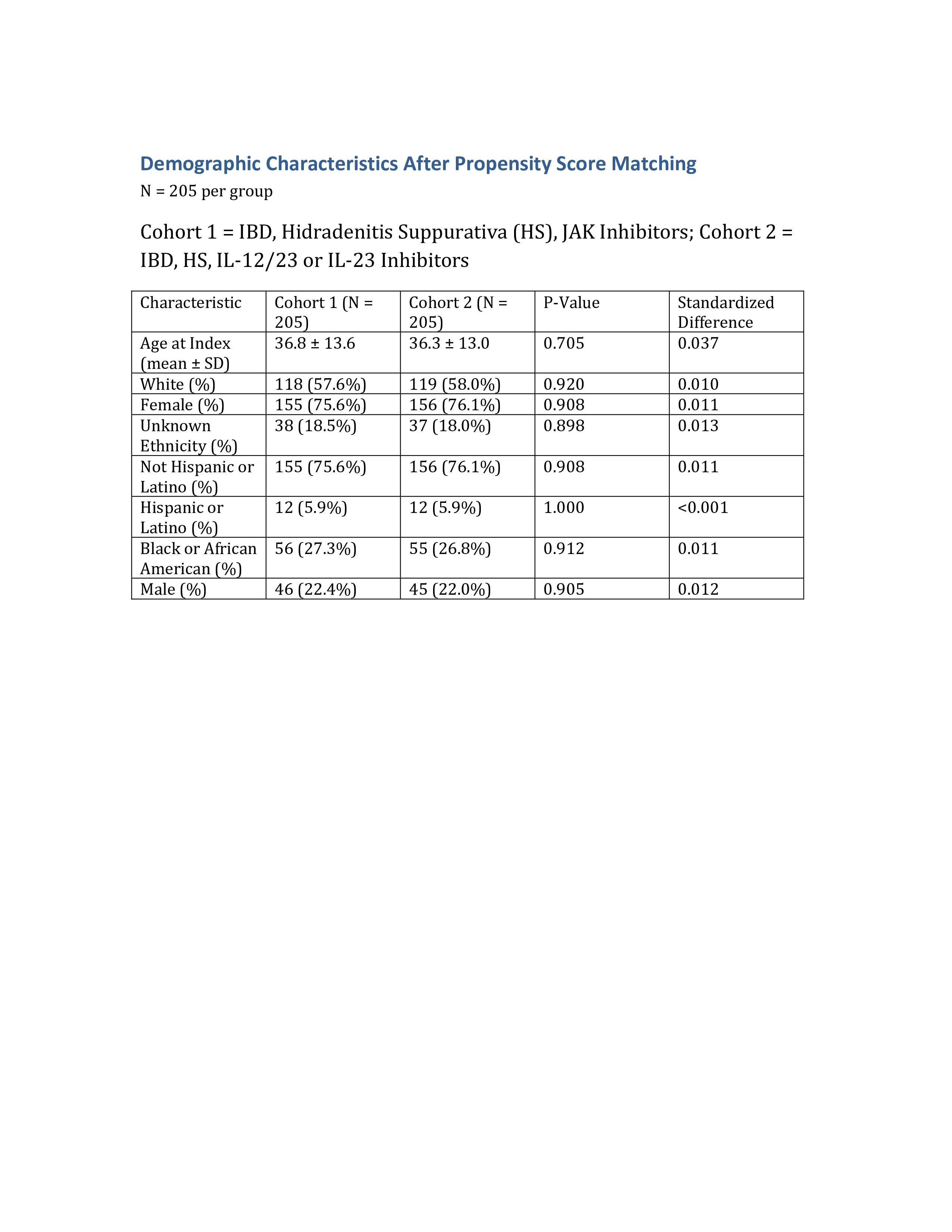Tuesday Poster Session
Category: IBD
P5441 - Real-World Comparative Effectiveness of JAK Inhibitors and IL-12/23 or IL 23 Inhibitors in IBD Patients With Hidradenitis Suppurativa: Associations With Steroid Sparing and Healthcare Resource Use
Tuesday, October 28, 2025
10:30 AM - 4:00 PM PDT
Location: Exhibit Hall

Ali Osman, MD, MSCI Candidate
Washington University School of Medicine in St. Louis
Ballwin, MO
Presenting Author(s)
Ali Osman, MD, MSCI Candidate1, Manar Shmais, MD2
1Washington University School of Medicine in St. Louis, Ballwin, MO; 2SSM Health Saint Louis University Hospital, Saint Louis, MO
Introduction: Inflammatory bowel disease (IBD) patients with concomitant Hidradenitis Suppurativa (HS) represent a challenging population with limited data on optimal biologic selection. Anti-TNF agents have historically been the preferred treatment option for managing coexisting IBD and HS due to their efficacy in both conditions. However, in anti-TNF exposed patients , there is paucity of evidence regarding the preferred line of medication in this subpopulation. Both IL-12/23 (Ustekinumab), IL-23 (Risankizumab, Guselkumab, Mirikizumab), and JAK inhibitors (Tofacitinib, Upadacitinib) are used in this setting, yet real-world comparative outcomes remain unclear. We aim to compare the clinical effectiveness and healthcare utilization of JAK inhibitors versus IL-12/23 and IL-23 inhibitors in patients with IBD and HS.
Methods: We conducted a retrospective cohort study using the TriNetX Global Collaborative Network. Adult patients (≥18 years) with a diagnosis of IBD and Hidradenitis Suppurativa treated with JAK inhibitors or IL-12/23 and IL-23 inhibitors were identified. Propensity score matching (1:1) was performed to balance demographics and baseline comorbidities. Outcomes included HS abscess drainage, emergency department (ED) visits or hospitalizations, steroid use, IBD complications, and antimicrobial use. Risk ratios and chi-square tests were used for comparisons.
Results: A total of 630 matched patients (315 per group) were analyzed:
· HS Abscess Drainage: Lower in the JAK group (5.4% vs 9.3%), but not statistically significant (p = 0.129).
· ED Visits & Hospitalizations: Significantly lower in the JAK group (24.9% vs 28.8%; p = 0.009).
· Steroid Use: Significantly reduced in the JAK group (43.9% vs 54.6%; p = 0.030).
· IBD Complications: Similar between groups (JAK: 9.0% vs IL-12/23 or IL-23: 8.3%; p = 0.855).
· Antimicrobial Use: Slightly lower in the JAK group (51.7% vs 57.1%; p = 0.275).
Discussion: In this real-world study, JAK inhibitors were associated with significantly lower rates of steroid use and reduced healthcare utilization compared to IL-12/23 and IL-23 inhibitors in IBD patients with HS. These findings suggest potential advantages of JAK inhibitors in managing this complex patient population.

Figure: Table-1: Demographic Characteristics After Propensity Score Matching

Figure: Clinical Outcomes in IBD Patients with HS: JAK VS IL-12/23 or IL-23 Inhibitors
Disclosures:
Ali Osman indicated no relevant financial relationships.
Manar Shmais indicated no relevant financial relationships.
Ali Osman, MD, MSCI Candidate1, Manar Shmais, MD2. P5441 - Real-World Comparative Effectiveness of JAK Inhibitors and IL-12/23 or IL 23 Inhibitors in IBD Patients With Hidradenitis Suppurativa: Associations With Steroid Sparing and Healthcare Resource Use, ACG 2025 Annual Scientific Meeting Abstracts. Phoenix, AZ: American College of Gastroenterology.
1Washington University School of Medicine in St. Louis, Ballwin, MO; 2SSM Health Saint Louis University Hospital, Saint Louis, MO
Introduction: Inflammatory bowel disease (IBD) patients with concomitant Hidradenitis Suppurativa (HS) represent a challenging population with limited data on optimal biologic selection. Anti-TNF agents have historically been the preferred treatment option for managing coexisting IBD and HS due to their efficacy in both conditions. However, in anti-TNF exposed patients , there is paucity of evidence regarding the preferred line of medication in this subpopulation. Both IL-12/23 (Ustekinumab), IL-23 (Risankizumab, Guselkumab, Mirikizumab), and JAK inhibitors (Tofacitinib, Upadacitinib) are used in this setting, yet real-world comparative outcomes remain unclear. We aim to compare the clinical effectiveness and healthcare utilization of JAK inhibitors versus IL-12/23 and IL-23 inhibitors in patients with IBD and HS.
Methods: We conducted a retrospective cohort study using the TriNetX Global Collaborative Network. Adult patients (≥18 years) with a diagnosis of IBD and Hidradenitis Suppurativa treated with JAK inhibitors or IL-12/23 and IL-23 inhibitors were identified. Propensity score matching (1:1) was performed to balance demographics and baseline comorbidities. Outcomes included HS abscess drainage, emergency department (ED) visits or hospitalizations, steroid use, IBD complications, and antimicrobial use. Risk ratios and chi-square tests were used for comparisons.
Results: A total of 630 matched patients (315 per group) were analyzed:
· HS Abscess Drainage: Lower in the JAK group (5.4% vs 9.3%), but not statistically significant (p = 0.129).
· ED Visits & Hospitalizations: Significantly lower in the JAK group (24.9% vs 28.8%; p = 0.009).
· Steroid Use: Significantly reduced in the JAK group (43.9% vs 54.6%; p = 0.030).
· IBD Complications: Similar between groups (JAK: 9.0% vs IL-12/23 or IL-23: 8.3%; p = 0.855).
· Antimicrobial Use: Slightly lower in the JAK group (51.7% vs 57.1%; p = 0.275).
Discussion: In this real-world study, JAK inhibitors were associated with significantly lower rates of steroid use and reduced healthcare utilization compared to IL-12/23 and IL-23 inhibitors in IBD patients with HS. These findings suggest potential advantages of JAK inhibitors in managing this complex patient population.

Figure: Table-1: Demographic Characteristics After Propensity Score Matching

Figure: Clinical Outcomes in IBD Patients with HS: JAK VS IL-12/23 or IL-23 Inhibitors
Disclosures:
Ali Osman indicated no relevant financial relationships.
Manar Shmais indicated no relevant financial relationships.
Ali Osman, MD, MSCI Candidate1, Manar Shmais, MD2. P5441 - Real-World Comparative Effectiveness of JAK Inhibitors and IL-12/23 or IL 23 Inhibitors in IBD Patients With Hidradenitis Suppurativa: Associations With Steroid Sparing and Healthcare Resource Use, ACG 2025 Annual Scientific Meeting Abstracts. Phoenix, AZ: American College of Gastroenterology.
